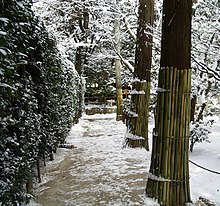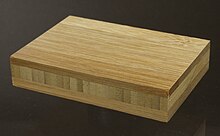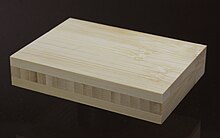Use of bamboo


Bamboo covers an area of around 37 million hectares worldwide , of which around six million are in China and nine million in India. 10 to 15 tons of biomass can be sustainably obtained per hectare per year.
Reliable figures on areas and economic importance are not available, among other things because bamboo is often used locally. In addition, bamboo is usually not recorded in forestry production statistics. Bamboo is an important, rapidly renewable raw material. Especially in Asia it is of great ecological, economic and cultural importance; For around 1.5 billion people, bamboo and its diverse uses are the basis of life. The lignifying giant grass has been a regional supplier of building materials and fuel for centuries. The spectrum of applications ranges from use as food to use as a building material for furniture and house construction, the production of textiles and bio-materials to the use of plant extracts (bamboo milk) in the manufacture of cosmetics and care products. Bamboo is also used energetically, for example in the form of bamboo pellets or bamboo charcoal.
Food

The use as food mainly affects the young shoots of the bamboo cane, which are eaten as vegetables or pickled in vinegar . The genera Bambusa , Dendrocalamus and Phyllostachys are particularly suitable for consumption. Freshly harvested bamboo shoots have a very firm, light yellow flesh with narrow air chambers in the middle of the shoots. They are obtained by digging them out of the ground and are surrounded by several very firm, hairy, dark brown leaves that are removed before cooking. Bamboo shoots are mainly imported from Asia and Latin America . In Europe, they are only grown in Italy. They are also offered for sale pre-cooked and packaged.
The shoots contain a toxin ( hydrocyanic acid glycoside ), which has to be hydrolyzed by boiling, whereby the resulting hydrocyanic acid evaporates. Since many types of bamboo also contain bitter substances, these should also be destroyed by cooking. In Japan bamboo shoots are z. B. cooked together with the flour that is created when polishing rice ("nuka") and mainly contains the outer layers of the rice grain. Pickled bamboo shoots are called " Achia " or "Atchia".
The oat-like grain of bamboo is also edible. The tea made from it mainly contains carbohydrates, fiber, proteins, fats, minerals and vitamins. It is said to help prevent migraines.
The use of fine bamboo powder (or fibers) as additives for food is economically successful. They are tasteless with a fiber content of over 98%. These bamboo products offer both the nutritional (e.g. fiber enrichment, calorie reduction) and technological (e.g. texture improvement, water retention) advantages of fiber concentrates and can therefore be used in many ways in product development. Although their use is not permitted in Germany, in particular in the USA and Canada as well as in Asia they are used for various foods and supplements, for example in fruit juices as well as in spices, tablets, baked goods and sauces.
In East Timor , meat is cooked in thick bamboo tubes. This preparation method is called tukir .
In South Korea , extract of bamboo leaves is used to make the medicinal wine Daetongju . Also, bamboo salt is made by roasting salt in bamboo. This is used in toothpaste, as a disinfectant and to aid digestion.
horticulture
In Chinese gardening , bamboo is an essential design element. Bamboo has also become increasingly popular in European gardens in recent years. Bamboo can u. a. can be used as a grove, hedge, ground cover, patio and courtyard greening, privacy and wind protection, for roof gardens, as a container plant or conservatory greening and can be used in many ways in terms of design.
Bamboo is an evergreen plant . 80 percent of all bamboo varieties offered in Germany (especially Fargesia , Phyllostachys ) are robust and can withstand temperatures down to −20 ° C for a short time.


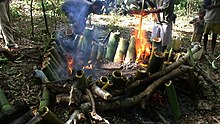
Building material
Bamboo is an easily available and at the same time a high quality raw material. In many properties bamboo is on a par with hardwood and in its toughness it is even superior to wood; the hollow spaces make bamboo extremely light and elastic.
While bamboo is often considered the “poor people's wood” in Asia, in Europe it is an exclusive material for interior decoration. Traditionally, bamboo is of greatest importance as a versatile building material. The use ranges from temporary buildings and house construction to furniture construction and technical constructions such as bridges made of particularly long Tonkin tubing . Dimensionally stable bamboo poles with a diameter appropriate for the application are required as a structural building material. In order to minimize the frequent formation of cracks, the age-appropriate harvested material has to be dried carefully and time-consuming. Depending on the use, the pipe is cut into strips (which also minimizes the formation of cracks), ground, further processed and, if necessary, surface treated.
Houses are traditionally built from the tough, light and very hard wood, but the use of modern building technology has declined significantly and, especially in cities, there are hardly any buildings made of bamboo today. In the past, entire villages were built from bamboo only, and most of the capital of Siam floated on bamboo rafts. Bridges and water pipes were also built from bamboo, as well as scaffolding and roads. For use as a building material, however, it is necessary that the bamboo is treated before it is used to make it resistant to fungi and insects. While this pre-treatment has so far mainly taken place chemically, solutions based on boron salt are currently being developed. When using bamboo as a building material, it is important that it is protected from moisture. This happens because the building does not stand on the ground, but on a moisture-resistant substructure (stones or concrete base) and a cantilevered roof protects the bamboo against moisture. In earthquake-prone areas (for example in Indonesia ) it has been shown that bamboo houses can cope with the tremors much better than brick houses.
Commodities
Bamboo is traditionally used in a variety of ways to manufacture furniture and all kinds of household appliances, including artfully woven baskets, curtains, boxes, and as a carrier material for lacquer art , etc. Ä. But other everyday objects such as hats, baskets and traps are made from bamboo. In addition, the long, curled scrap is used for upholstery. A chip with a wedge-shaped cross-section, the sharp edge of which is formed by the extremely hard layer rich in pebbles, makes a very sharp knife, the same layer also serves as a whetstone for iron knives. In a bamboo tube, which charred but not burned, the Javanese cooked young bamboo plants over a bamboo fire. In China, strips of bamboo tied into rolls were used as writing material. Knocked bamboo splint can be used as a brush. A climbing species is made into all kinds of wickerwork, sacks, and even jackets. In Europe, too, bamboo was used for the production of sticks (pepper cane) and umbrella handles, and bicycles can also be made from bamboo .
Housewares
Mats, baskets and vessels are woven from narrow, veneer-like strips of various types of bamboo. With the help of yarn these strips can also be connected to floor coverings or blinds; they are hard as wood and can be rolled up like a fabric. In East Timor , food is cooked in bamboo poles over a fire.
Bamboo as a filler
As an alternative to plastic materials, dishes, including special children's dishes, which, according to the manufacturer, mainly consist of ground bamboo and cornmeal, are offered. Material tests have shown that these dishes have been mixed with high additions of melamine resin as a binding agent and are therefore less ecological than claimed.
In July 2020, the ORF's consumer department criticized the misleading mere indication of "bamboo" for crockery and cutlery made of melamine material filled with bamboo flour or fibers and rated all of the children's dishes examined with a grade of 5 (insufficient), mainly because too much of the harmful substances melamine and Formaldehyde. Often there is no indication that melamine resin dishes can only be heated up to 70 degrees Celsius. Children chew on cutlery and vessels. Strictly speaking, bamboo is not wood and only wood is permitted as a contact material for food.
Musical instruments
Musical instruments are made from bamboo in many regions around the world. In Indonesia there is the shaker idiophon angklung , and many Asian slit drums are made of bamboo. Rattling bamboo and beating pieces of bamboo against each other are common in New Guinea music . Well-known Japanese bamboo flutes are the shakuhachi and shinobue , in China they are dizi and xiao , in Indonesia the suling and in India the transverse flute bansuri is played in folk and classical music. The chivoti on the Kenyan coast was probably taken over from India. The South American Andean music includes the flute quena and the pan flute zampano . A new development from the 1970s is the clarinet-like xaphoon . The trutruka of the Chilean and Argentine Mapuche is a natural trumpet and is made from Colihue bamboo. An unusual wind instrument in Indonesia, consisting of two tubes of different thicknesses, is called bumbung from the Indonesian word for "bamboo tube".
The simplest stringed instruments made of bamboo are idioglotte bamboo tubes zither , in which several strings are cut out of an internode and the ends remain connected to the tube. These are widespread in Southeast Asia, for example on the Indonesian islands of Java ( celempung bambu ), Bali ( guntang ) and Roti ( sasando ) as well as on the Philippines ( kolitong ). The Vietnamese đàn bầu , which is strung with a single steel string , was also made from a bamboo tube in the past. The gintang and the chigring are among the idioglottic tubular bamboo zithers in northeast India with a few strings that are struck with a bamboo stick . The Malagasy valiha with about 20 strings is plucked. In raft zithers, which occur mainly in Africa, several bamboo tubes are connected in parallel.
Occasionally, individual organ stops are made with bamboo pipes. The organ in the Catholic Church in Las Pinas near Manila // Philippines mainly contains pipes made of bamboo.
weapons
Bamboo was also made into weapons: blowguns , arrow shafts and arrowheads, lances and palisades were made of the material. In Japan, the samurai's yumi ( bows ) were made from bamboo in a complicated process . Similar bamboo bows are also used today in Japan and by advanced archers in Europe in kyūdō . Traps and pitfalls equipped with bamboo tips were used by the National Front for the liberation of South Vietnam during the Vietnam War in the 20th century . Also in Kendō , so-called Shinai , which also consist of bamboo struts, are fought.
Materials
Panel materials take up an important new market for bamboo producers. The products are only about half as expensive as the competing wood-based materials . Because of its high stability and strength, bamboo is an ideal material for glued panels and chipboard (OSB; Oriented Strand Board). Bamboo plywood has been produced for many years. It is used in large quantities for planking trucks. In structural engineering, new paths are currently being explored in terms of earthquake security using bamboo elements. Temporary buildings and filigree constructions are being implemented more and more often despite strict building regulations. Low weight and high tensile strength are the technical and economical advantages of bamboo in all high-tech applications. At the adream design competition initiated by the Free State of Thuringia, the self-supporting lightweight bamboo panel Conbou was awarded.
Bamboo flooring has been on the market for around 20 years. For the parquet, the blanks are split, the inner knots and outer skin are removed and roughly sanded. Then the parquet is "caramelized", for this purpose the bamboo is treated with steam, which changes the sugar content in the plant and the wood becomes darker. After drying, the material is glued and pressed as well as fine sanded and varnished. The demand for such parquet has increased worldwide due to its good design and technological properties. A further development is parquet made of compacted bamboo with a resin system as a binding agent, a durable material with a comparatively high density of 1,100 kg / m³ (bamboo raw material: 600–800 kg / m³) and a visually attractive surface. The product is offered as an alternative to tropical hardwood for parquet and terrace flooring.
Bamboo can also be combined well with other materials. As high-quality fibers with a favorable length-to-thickness ratio, bamboo has a reinforcing effect, for example in combination with plastics; as sanding dust (e.g. residues from panel production) it has a stiffening effect in composite materials . The addition of natural substances should also lead to a more stable, petroleum-independent price for the plastic compounds. Composite materials containing bamboo have been successfully launched on the market for several years; in Asia they are traded under the name Wood-Plastic-Composites (WPC). In the USA and Europe, however, this designation is usually understood to mean reinforced composite materials filled with softwood fibers. For specially processed bamboo fibers, especially in combination with bioplastics , significant market opportunities are seen in future material development. Larger amounts of bamboo fibers can also be used in concrete as an inexpensive aggregate and fiber reinforcement, as tests in Asia and Europe have shown. The market for such innovative biomaterials is growing at annual growth rates of up to 50 percent.
Lightweight construction
Bamboo is hollow on the inside and therefore, like many other grasses, has knots, which serve the stability of the stalk and prevent it from twisting. This is a very simple lightweight structure, which is why the principle is also being investigated by bionics . The knots, which are arranged in a ring, serve as a tension rope on the tensioned side and as a support on the compressed side, which both prevent the cross-section from becoming oval and ultimately kinking.
Pulp and textiles
Bamboo contains only 1.5–4 mm short cellulose fibers with an outer diameter of 11 to 19 μm and a hollow diameter of 2 to 4 μm, which are therefore not spinnable. The clothing, especially stockings, often offered today for marketing reasons as “bamboo textiles” (woven bamboo) consists of viscose fibers . Here bamboo only serves as a raw material for the cellulose obtained from it in a chemical process and processed into viscose fiber . In addition to bamboo, other sources of cellulose such as beech, birch, pine, spruce, pine or eucalyptus can also be used for the production of viscose fibers. As a rule, the term “bamboo textiles” is therefore misleading the consumer. There are also textiles made from real bamboo bast fiber. The bamboo bast fiber is subjected to a processing process that is comparable to the production of linen fibers. Then the bamboo bast fiber is spun into a yarn in a long or short staple process .
Historically, most of the paper in China was made from the pulp of young bamboo industries. Bamboo has been used extensively in the Asian and South American pulp and paper industries for decades. The share of bamboo is seen globally and assessed as declining relative to the use of wood, because the fast-growing eucalyptus and the long-fiber pine trees provide economic advantages for the industry, but China is mainly due to the huge (domestic) demand and limited wood stocks continue to rely on bamboo. In Jamaica , a lot of bamboo fiber is extracted for North American paper manufacture.
ingredients
Bamboo camphor (bamboo sugar, tabachir) is a chemical raw material that develops as concretion from the aqueous solution in individual bamboo species. The substance forms irregular, pea-sized, white-yellowish or brownish, opal-like translucent deposits in the internodes of the plant. They can easily be scraped out of the split stalk by hand and represent an additional income for bamboo owners. Bamboo camphor is also used as a polishing agent in Chinese medicine. It is exported in large quantities to Arab countries.
Other basic chemical substances, especially flavonoids , are obtained from the bamboo leaves. Flavonoids occur in a variety of structures in practically all food plants. Most flavonoids are bound to glucose or rhamnose and act as antioxidants . However, many of the active functions are still unexplored and great potential is seen here. The cosmetics industry in particular has taken advantage of the benefits and is increasingly using flavonoid-containing plant extracts in anti-wrinkle or sun creams, combined with vitamins. In Europe, personal care products (shower gel, soap, bath additives, etc.) and drugs with such ingredients are also on the market.
Energetic use
Bamboo charcoal is a well-known energy source in Asia for cooking and heating - and an important energy source for industry. China exports larger amounts of this charcoal to Japan every year. The high-density bamboo charcoal burns two and a half times longer than conventional charcoal. For some years now, new, higher-value applications have been developed from this market, for example filter systems for industry or for water treatment, deodorants or high-quality drawing charcoal. Bamboo pellets are not only a competitive alternative to firewood in terms of price: Bamboo has three times the energy content with the same bulk density. The global market is growing rapidly; in the Netherlands and Great Britain alone, demand rose from zero to over a million tonnes in two years.
The primary burning of bamboo, however, is viewed critically in a similar way to wood - as a rule, the material use or the manufacture of high-quality products offers significantly higher added value. In the sense of a cascade use , thermal recycling can still stand at the end of the product life. In addition, process and transport emissions have a negative impact on the ecological balance and the basically CO 2 -neutral combustion of biomass . In the village area there is often no alternative to incineration, as the residents have to access material for cooking or heating that is available at short notice.
Cultural meaning
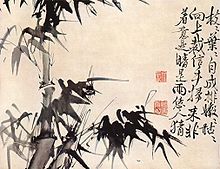
Various symbolic meanings are assigned to the bamboo. For example, it is a symbol of longevity in China and a symbol of friendship in India. In the Philippines, bamboo crosses are set up by farmers as a good luck charm.
In Japan, bamboo is also a positive term. Bamboo grows very straight and its fresh green color makes it a symbol of purity. It also appears as a symbol together with pine branches and plum blossoms. The three plants are not only used as symbols of good luck, but also to B. to mark different price levels for sushi (from bottom to top: shō - chiku - bai , pine - bamboo - plum). At the end of the year, a bundle of pine branches and often bamboo canes is placed on each side of the entrance door, which is said to bring good luck ( kadomatsu ).
Since bamboo rarely blooms and the seeds were mainly eaten during times of hunger, the bamboo blossom is interpreted in some cultures as a harbinger of famine. In the northern Indian state of Mizoram , the flowers attracted rats , which multiplied greatly thanks to the protein-rich bamboo fruit and after flowering attacked the fields in the area. In some cultures in Asia, e.g. B. in the Andamans , it is assumed that mankind stepped out of a bamboo cane when it was formed. In Malaysia there is a similar legend about a man who after a dream cuts a bamboo cane and finds a beautiful woman in it. The Japanese Taketori Monogatari tells of a moon princess who is found as a baby in a glowing bamboo tube.
Certain types of bamboo were used in what is known as bamboo torture in Japan during World War II .
literature
- Simon Crouzet, Oliver Colin: Bamboo. Agricultural Publishing House, 2003, ISBN 3-8001-4195-7 .
- Christian Gahle, Alexandra Brunnert: Bamboo: From regional building material to global raw material. Bamboo Journal 3/2008; ISSN 0942-4679 .
- Friedrich Eberts: Bamboo. The most beautiful species and varieties. Maintain and design plants. BLV, Munich 2008, ISBN 978-3-8354-0455-7 .
Individual evidence
- ^ Korean Traditional Liquors Receive Recognition Around the World. (No longer available online.) In: Agrafood. August 1, 2013, archived from the original on January 29, 2017 ; accessed on January 29, 2017 (English).
- ↑ Bamboo bicycle from 1895 ( Memento from April 3, 2015 in the Internet Archive )
- ↑ Öko-Test February 2016: Children's dishes. Eco test
- ↑ Iris Eckstein, Magdalena Lubecki, Uwe Lauber: Deception: Supposedly ecological tableware made of bamboo consists to a large extent of synthetic plastic. In: Chemical and Veterinary Investigation Office Stuttgart. November 10, 2014, accessed April 1, 2017 .
- ↑ High pollution levels in children's dishes, help.orf.at, accessed July 25, 2020.
- ↑ The bamboo organ from Las Pinas / Philippines. November 10, 2014, accessed September 18, 2017 .
- ^ Production of bamboo parquet. Retrieved July 9, 2017 .
- ^ Walter Liese: The Anatomy of Bamboo Culms. BRILL, 1998, ISBN 978-8-186-24726-6 .
- ↑ Werner Nachtigall: Bionics by Examples. Springer, 2014, ISBN 978-3-319-05858-0 . P. 194.
- ^ Walter Liese: Bamboo. Springer, 2015, ISBN 978-3-319-14133-6 , p. 334.
- ↑ Textiles made of bamboo - appearance or reality (PDF; 76 kB), statement by Hans-Jürgen Kleine (EBS - European Bamboo Society Section Germany eV)
- ↑ bambus-city.de: The cultural significance of the bamboo plant
- ↑ Rare bamboo blooms lead to rat plague in India
- ↑ Japanese Torture Techniques. WW 2 People's War, BBC History

